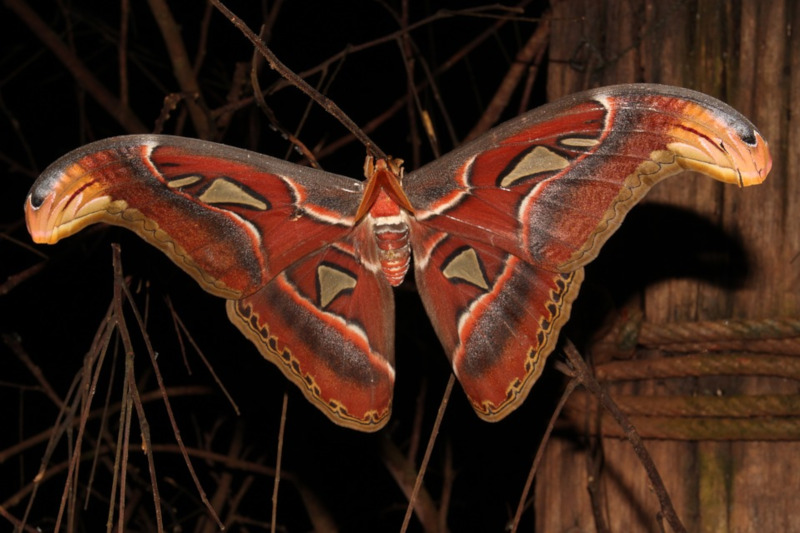
Giant Atlas Moth Facts
- Perhaps most notably, the aptly named Giant Atlas Moth ranks as one of the largest species of Lepidoptera in the world. In point of fact, only one known species possesses a greater wingspan. This fact alone makes it stand out from its peers.
- Only one other species, meanwhile, has a slightly greater surface area. Quite understandably, its common name derives from the famous Titan Atlas, from Greek mythology. In this species, Nature truly worked overtime to produce a marvel.
- For the moment, the population numbers of this gorgeous arthropod appear to be reasonably stable. That further holds true throughout the entirety of its range. The IUCN therefore does not presently list the insect on its Red List of Threatened Species.
- That status could easily change in the future, however, depending on ongoing factors currently being seen around the world. While the Giant Atlas Moth inhabits a large area of the world, it nevertheless faces several threats to its continued existence.
- One of these dangers unfortunately consists of habitat loss, as humans encroach on more and more of its habitat. It also faces another danger, however. That’s the ever-escalating threat posed by climate change, much like other species presently face.
Related Articles
Giant Atlas Moth Physical Description
The most readily noticeable physical trait of the stunning Giant Atlas Moth, not surprisingly, given its common name, remains its great size. That’s because mature individuals of the amazing species attain an average wingspan totaling roughly 9.4 in (24 cm).
These remarkably large and powerful wings further develop an overall surface area that totals roughly 25 sq in (160 sq cm). However, it does mirror its peers in one way. The arthropod also displays a moderate degree of the biological trait of sexual dimorphism.
In its case, though, this physical trait presents itself in a total of three different ways. The females of this marvelous Lepidoptera typically have a greater wingspan and girth than males. The smaller males, meanwhile, develop significantly broader antennae.
The body of the Giant Atlas Moth, though, remains extremely small in relation to the large wings. The upper portion of these wings typically presents a reddish-brown color. These also display a pattern of white, pink, black, and purple lines, however.
Its beauty doesn’t stop there, though. Many light colored, triangular-shaped patches also appear, bordered in black. The underside of the insect, however, remains much paler. An incredible extension on the tip of each wing also closely resembles the head of a snake.
- Kingdom: Animalia
- Phylum: Arthropoda
- Class: Insecta
- Order: Lepidoptera
- Family: Saturniidae
- Genus: Attacus
- Species: A. atlas
Giant Atlas Moth Distribution, Habitat, and Ecology
The magnificent Giant Atlas Moth inhabits a truly expansive territorial range. More precisely, that range of habitation actually covers much of the southeast portions of Asia. The fabulous invertebrate also appears to be especially prevalent on the island of Borneo.
This fascinating species of moth also inhabits large sections of China, India, and the Malay Peninsula. Scattered groups of the magnificent Lepidoptera also appear in other areas, however. Within this region, it primarily inhabits areas of lush, tropical forests.
Smaller populations also thrive in secondary forests, and shrublands, though. The choice of habitat plays a key role in its survival, since its caterpillar form relies entirely on the local plants for food. The larvae feed voraciously, primarily on citrus and evergreen trees.
Unfortunately, the adult lifespan of the Giant Atlas Moth evolved as quite short. In fact, this lasts for only 1-2 weeks once the individual opens its wings. During this time the individual subsists entirely on fat reserves which it accumulated during its larval stage.
This holds true due to the fact that adults do not possess functioning proboscis. It also flies as little as possible after leaving its cocoon. In fact, most females rarely move at all. These wait for males, mate, then die, averaging an adult life stage of 1-2 weeks.
Species Sharing Its Range
Check out our other articles on 7 Spectacular Herbaceous Plants of the World, Japanese Angelshark, Hot Water Beach, Monkey Puzzle Tree, Seychelles Sheath-Tailed Bat, Hermann’s Tortoise
